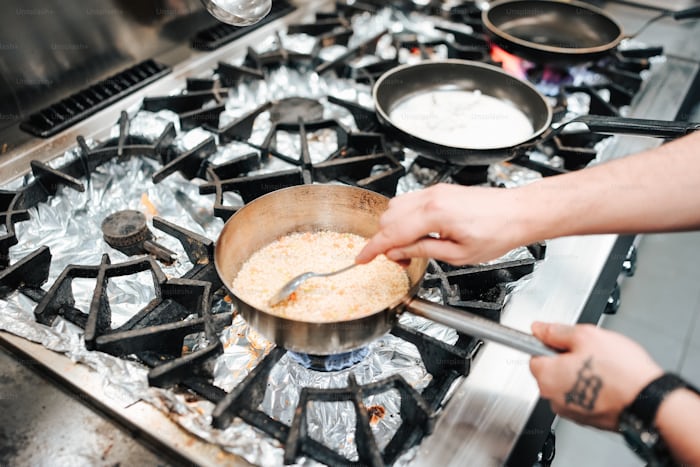When it comes to kitchen essentials, few items stand the test of time like a cast iron pan. These sturdy, versatile pans have been a staple in kitchens around the world for centuries, valued for their durability, even heating, and ability to improve with age. Whether you’re a seasoned home cook or just starting out, a cast iron pan is an invaluable tool that can elevate your culinary creations. In this article, we’ll explore the many benefits of using a cast iron pan, how to properly use and care for it, and why it deserves a place in your kitchen.
The Benefits of Using a Cast Iron Pan
1. Durability and Longevity
One of the most significant advantages of cast iron pans is their incredible durability. Unlike non-stick pans that can wear out over time, a well-maintained cast iron pan can last a lifetime, and often even longer. In fact, many people use cast iron pans that have been passed down through generations. This longevity is due to the pan’s solid construction, which makes it resistant to warping, cracking, and other common issues that affect lesser cookware.
2. Superior Heat Retention and Distribution
Cast iron pans are known for their excellent heat retention and even heat distribution. Once heated, they maintain a consistent temperature, making them ideal for tasks that require steady heat, such as searing steaks, browning meats, or frying foods. The ability to evenly distribute heat across the cooking surface ensures that your food cooks uniformly, reducing the chances of hot spots that can burn food. This characteristic also makes cast iron pans perfect for slow cooking and baking, as they can hold and maintain heat for long periods.
3. Versatility in Cooking
Few pieces of cookware are as versatile as a cast iron pan. You can use it for a wide range of cooking methods, from frying and sautéing to baking and roasting. It can be used on various heat sources, including gas, electric, and induction stovetops, as well as in the oven, on the grill, or even over an open flame. This versatility makes cast iron pans perfect for one-pan meals and allows you to easily transition from stovetop to oven when cooking dishes like frittatas, cornbread, or casseroles.
4. Natural Non-Stick Surface
Over time, a cast iron pan develops a natural non-stick surface known as seasoning. Seasoning is the result of cooking oils and fats being baked into the pan’s surface, creating a slick, non-stick layer that improves with use. This natural non-stick surface not only makes cooking and cleanup easier but also eliminates the need for synthetic coatings found in many non-stick pans, which can wear off or release harmful chemicals when overheated.
5. Health Benefits
Cooking with a cast iron pan can also provide some health benefits. Unlike non-stick cookware that may contain chemicals, cast iron pans are free from potentially harmful substances. Additionally, cooking with cast iron can help increase your iron intake, as a small amount of the mineral leaches into food during cooking. This can be particularly beneficial for individuals with iron deficiencies or those looking to boost their iron levels naturally.
How to Properly Use a Cast Iron Pan
To get the most out of your cast iron pan, it’s essential to know how to use it properly. Here are some tips to ensure great results every time you cook:
1. Preheating is Key
Preheating your cast iron pan before adding any ingredients is crucial for achieving the best results. Because cast iron is such a dense material, it takes longer to heat up compared to other types of cookware. Allow the pan to preheat on medium heat for about 5-10 minutes to ensure even heat distribution. A properly preheated pan will help prevent food from sticking and promote even cooking.
2. Use the Right Cooking Oil
When cooking with cast iron, it’s important to use the right type of cooking oil. Choose oils with a high smoke point, such as vegetable oil, canola oil, or grapeseed oil. These oils are less likely to burn and will contribute to the pan’s seasoning over time. Avoid using butter or olive oil for high-heat cooking, as they have lower smoke points and can burn more easily, leading to a sticky residue on the pan’s surface.
3. Avoid Cooking Acidic Foods in a New Pan
While cast iron pans are incredibly durable, they are reactive to acidic foods like tomatoes, vinegar, and citrus. Cooking acidic ingredients in a new or lightly seasoned pan can strip away the seasoning, leaving the pan susceptible to rust and causing a metallic taste in your food. If your pan is well-seasoned, you can cook acidic foods occasionally, but it’s best to avoid doing so frequently.
4. Avoid Drastic Temperature Changes
Cast iron pans are sensitive to sudden changes in temperature, which can cause them to crack or warp. To avoid this, never place a hot pan under cold water or move it directly from a hot stovetop to a cold surface. Allow the pan to cool gradually before cleaning or adding any liquid.
How to Care for Your Cast Iron Pan
Proper care is essential for maintaining your cast iron pan’s performance and longevity. Here are some simple steps to keep your pan in top condition:
1. Clean Immediately After Use
It’s best to clean your cast iron pan immediately after use to prevent food from sticking and to avoid any potential for rust. Use a stiff brush or sponge and hot water to clean the pan, avoiding soap unless absolutely necessary. Soap can strip away the seasoning, so if you do use it, make sure to re-season the pan afterward. For stubborn, stuck-on food, scrub with coarse salt and a little water, then rinse and dry thoroughly.
2. Dry Thoroughly to Prevent Rust
After washing your cast iron pan, dry it thoroughly with a clean cloth or paper towel. Any remaining moisture can lead to rust, which can damage the pan. To ensure it’s completely dry, you can place the pan on a stovetop burner over low heat for a few minutes. This will evaporate any remaining moisture and help maintain the pan’s seasoning.
3. Re-Season Regularly
Regular seasoning is key to maintaining a non-stick surface and protecting your cast iron pan from rust. To re-season your pan, apply a thin layer of oil to the entire surface, including the handle and the bottom, and place it upside down in a preheated oven at 375°F (190°C) for about an hour. This process allows the oil to bond with the metal, creating a slick, protective layer. Be sure to place a baking sheet or aluminum foil on the rack below to catch any drips.
4. Store Properly
When storing your cast iron pan, make sure it’s completely dry and free from any moisture. You can place a paper towel or a cloth inside the pan to absorb any moisture and prevent rust. If stacking with other pans, place a protective layer, such as a cloth or paper towel, between the pans to avoid scratches and maintain the seasoning.
Common Myths and Misconceptions About Cast Iron Pans
Despite their popularity, there are several myths and misconceptions about cast iron pans that can deter people from using them. Let’s debunk some of these common myths:
1. “Cast Iron Pans Are Difficult to Maintain”
Many people believe that cast iron pans require excessive maintenance and are challenging to care for. In reality, caring for a cast iron pan is relatively simple and straightforward. With proper cleaning, drying, and seasoning, a cast iron pan is easy to maintain and will provide reliable performance for years.
2. “You Can’t Use Soap on a Cast Iron Pan”

While it’s generally best to avoid using soap on a cast iron pan to preserve the seasoning, using a small amount of mild soap occasionally won’t ruin the pan. Just be sure to rinse thoroughly and re-season the pan if necessary.
3. “Cast Iron Pans Heat Unevenly”
Some people believe that cast iron pans heat unevenly, but this is a misconception. Cast iron pans do take longer to heat up due to their density, but once heated, they distribute heat evenly across the cooking surface. This property makes them ideal for tasks that require consistent heat.
Conclusion
A cast iron pan is a versatile, durable, and reliable tool that belongs in every kitchen. With its excellent heat retention, natural non-stick surface, and ability to last a lifetime, it’s no wonder that cast iron pans have remained a favorite among home cooks and professional chefs alike. By understanding the benefits, proper usage, and care tips, you can make the most of your cast iron pan and enjoy delicious meals for years to come. Whether you’re frying, baking, roasting, or sautéing, a cast iron pan is an indispensable kitchen companion that can elevate your cooking experience.





